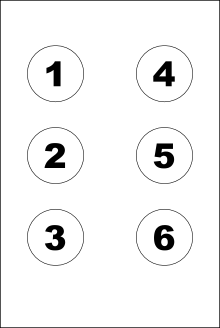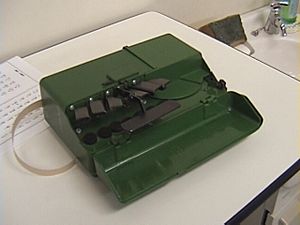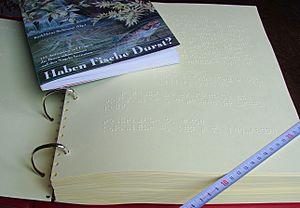Braille facts for kids
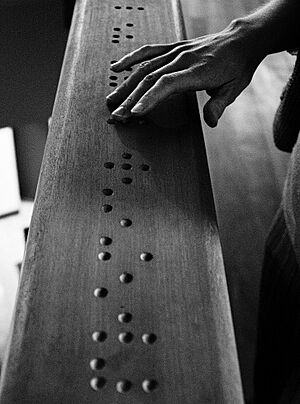
The Braille system is a special way of writing. It was created by Louis Braille, a French man. Blind people use it to read and write. The Braille system uses raised bumps or dots that you can feel with your fingers. Each pattern of dots stands for a letter, number, or punctuation mark.
Contents
How Braille Was Invented
Louis Braille was not the first person to think about how blind people could read and write. Many people tried different ideas before him.
Early Ideas for Blind Reading
In the 17th century, an Italian man named Francesco Lana thought about ways for blind people to read. He invented a system using dashes that could be felt.
Later, Valentin Haüy in France became interested in helping blind people communicate. He was born in Picardy in 1745. Haüy believed the biggest problem for blind people was that they could not read. He created a system that let them read and write sentences. He even started a school for blind children. His writing system used two columns with dots.
Charles Barbier's "Night Writing"
Charles Barbier developed a similar system. He created it because Napoleon wanted a secret way for soldiers to send messages silently at night. Barbier called his system "night writing". It used two columns of six dots. Instead of letters, it used phonemes, which are separate sounds.
Barbier's system was too hard for soldiers to learn. But in 1821, he started testing it at the school Haüy had founded. There, it became very helpful. Even though it was difficult, it allowed blind people to read better than before. Barbier realized that dots worked better than lines for reading by touch.
Louis Braille's Big Idea
Barbier met Louis Braille at the National Institute of the Blind. Braille saw a problem with Barbier's system: a finger could not feel the whole symbol at once. This made it hard to read quickly. Braille's big change was to use a smaller, 6-dot cell. This new Braille system completely changed how blind people would read and write.
The Braille Alphabet
Braille can be thought of as one of the first ways to encode characters using a binary system. The system Louis Braille invented had two main parts:
- It defined the letters of the French language using groups of six "dots."
- It showed these six-dot characters as raised dots in a Braille cell.
Today, Braille is used for many different languages. For each language, the letters are coded differently, depending on the alphabet. This list of codes is called a braille code. There are also special Braille codes for things like shorthand, mathematics, or music.
To help people read faster, some Braille systems use shortened words or contractions. This is known as Grade 2 Braille.
The Braille Cell
Braille uses cells that have six raised dots. These dots are arranged in two columns with three dots in each. The dot positions on the left are numbered one to three. The dots on the right are numbered four to six, as you can see in the picture.
Each Braille symbol is made by having certain dots raised and others flat. The raised dots are about 0.02 inches (0.5 mm) high. Inside a cell, the dots are about 0.1 inches (2.5 mm) apart. The space between two Braille cells is about 0.15 inches (3.75 mm) horizontally and 0.2 inches (5 mm) vertically. A standard Braille page is 11 inches by 11 inches. It usually has about 40 to 42 Braille cells per line and 25 lines.
How Braille Letters Are Coded
When Louis Braille first created his system, the first group of characters used only the top four dots of the Braille cell. These dots represented letters "a" through "j." This group of ten characters is called a decade.
To make letters "k" through "t," dot 3 (bottom left) is added to each of the "a" through "j" symbols. For letters "u," "v," "x," "y," and "z," both bottom dots (dots 3 and 6) are added to the first decade. The letter "w" was not included in this group because the French language did not use "w" when Louis Braille made his alphabet.
In English Braille, there are codes for letters, some punctuation, and some common double letters or words. However, you need a special prefix symbol for capital letters and numbers. In the United Kingdom, Braille often does not use capital letters.
There are also Braille codes for writing shorthand (like quick notes) and for mathematics (Nemeth Braille). There is even a system for musical notation (braille music).
Writing Braille
You can create Braille in a few ways. One way is by hand, using a "slate" and a "stylus." This involves pressing each dot from the back of the page, so you write in reverse. Braille can also be made with a special Braille typewriter called a "Perkins Brailler." Another method is using a braille embosser connected to a computer. Some blind people also use a refreshable braille display, which changes the dots electronically.
More Dots for Braille
The six-dot Braille code is limited, with only 64 possible combinations. This means that some things need more than one Braille character. For example, in English Braille, numbers need a special symbol first to show that the next symbols are numbers. This number symbol is usually only given once. All symbols that follow are read as numbers until there is a space.
Braille has been expanded to an 8-dot code, especially for computer use with Braille embossers and displays. In 8-dot Braille, two extra dots are added at the bottom of the cell. This makes a cell that is four dots high and two dots wide. The new dots are called 7 (lower-left) and 8 (lower-right).
8-dot Braille has some advantages. For example, capital and lowercase letters can be directly coded in one cell. This means a capital letter doesn't need two cells. All the common ASCII characters (like those on a computer keyboard) can be shown in a single cell. All 256 possible combinations of 8 bits are included in the Unicode standard. Braille with six dots is often stored as braille ASCII on computers.
Different Kinds of Braille
Grade 1 Braille
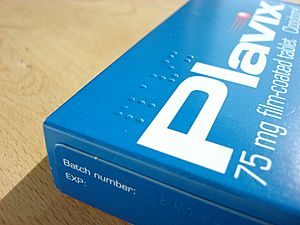
Grade 1 Braille is the simplest way to write Braille. Each letter is replaced with its Braille code. Beginners often use Grade 1 Braille.
The main challenge with Grade 1 Braille is that Braille letters are much larger than printed ones. A standard Braille page is 11 inches by 11 inches (28 cm by 28 cm). It only has room for about 25 lines of 40 characters. This means a Braille book would be very thick compared to a regular printed book.
Grade 2 Braille
Because of the size issue, most English Braille books use Grade 2 Braille. This system uses contractions, which are shortened words. This saves space and helps people read faster. Experts who study languages developed Grade 2 Braille. Transcribing a text into Grade 2 Braille is complex and requires special training.
In English, 23 common words are replaced with a single letter. For example, the word but becomes the letter b, can becomes c, and do becomes d. Even these simple rules have exceptions. For instance, only the verb to do is shortened to d. The noun do (like a note in music) is written out fully.
Sometimes, parts of words are contracted. A Braille character can even mean different things depending on where it is in a word. For example, the character for the letter "f" (dots 2-3-5) can mean "ff" when it's in the middle of a word. At the beginning of a word, the same character stands for the word "to." At the end of a word, it means an exclamation point.
Contraction rules cannot be used if they would cause problems with prefixes or suffixes on a word. Also, some rules are flexible. If a word can be written in more than one way, the one that sounds closer to the correct pronunciation is usually chosen.
Grade 3 Braille
Grade 3 Braille includes many more contractions. It is almost like a shorthand system. It is rarely used for books. However, people use it to write and read quickly for themselves, especially for taking notes.
Other Ways Blind People Read
Braille may not be the main way all blind people read and write today. In Britain, for example, only a small percentage of visually impaired people use Braille. In the U.S., a 2015 report showed that out of legally blind students, only about 8.6% were registered as Braille readers.
However, knowing Braille can be very helpful. Among blind adults in the United States, 90% of those who can read Braille are employed. For those who do not know Braille, only 33% are employed.
Many younger people now use electronic text on computers. Software programs can read this text aloud. This is a good way for them to communicate with friends. Technology continues to improve. There are also audiobooks and digital talking books available.
A useful term to know is "accessible publishing." This means books and other texts are available in formats that help or replace reading. Examples include:
- Larger fonts
- Special fonts for certain reading difficulties
- Braille
- E-books
- Automated audiobooks and digital talking books
This shows that Braille is just one of many options for people with visual impairments. There are also many more partially sighted people than fully blind people, and they have even more choices.
Braille for Other Languages
Braille has been expanded to include extra letters with diacritics (special marks), like ç, ô, é.
When Braille is adapted for languages that do not use the Latin alphabet, the Braille patterns are usually assigned based on how the letters are transliterated (written using Latin letters). They are not based on the original alphabet's order. This is true for Russian (Cyrillic), Greek, Hebrew, Arabic, and Chinese. For example, in Greek, gamma is written like the Latin g, even though it's the third letter of the Greek alphabet.
There are more differences in Chinese Braille. In Mandarin Braille, which is based on Zhuyin (a phonetic system) rather than the Latin Pinyin alphabet, the Latin Braille values are used for the first consonants and simple vowels. There are extra patterns for tones, diphthongs, and vowel-consonant combinations. Cantonese Braille also uses Latin Braille for many initial consonants and simple vowels. However, the patterns have different meanings depending on whether they are at the beginning or end of a syllable.
But at least two Braille adaptations have completely changed the Latin sound values of the patterns:
- Japanese Braille
- Korean Braille
In Japanese Braille, signs for a consonant and vowel are combined into one syllable block. In Korean Braille, consonants have different forms depending on if they are at the beginning or end of a syllable. These changes made Braille work much better with Japanese kana and Korean hangul. But it meant the original Latin sound values could not be kept.
Trained Braille readers can read about 100 words per minute. People who can see well usually read around 250 to 300 words per minute.
Images for kids
-
A Braille plate at the Duftrosengarten (Rose Garden) in Rapperswil, Switzerland
See also
 In Spanish: Braille para niños
In Spanish: Braille para niños


